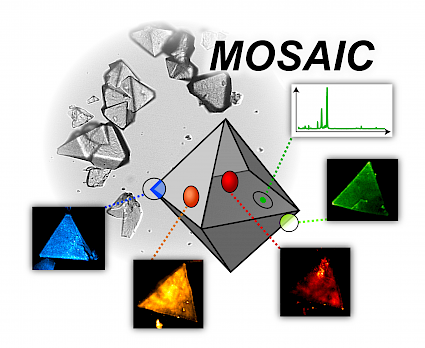 Group of Dr. Ploetz - Faculty for Chemistry and Pharmacy
Group of Dr. Ploetz - Faculty for Chemistry and Pharmacy
 Group of Dr. Ploetz - Faculty for Chemistry and Pharmacy
Group of Dr. Ploetz - Faculty for Chemistry and Pharmacy
To study complex uptake processes in situ or in vivo, it is necessary to access multiple information regimes in a correlated manner. For biological samples one w ould like to have state-of-the-art single molecule fluorescence imaging methods (e.g. multiple excitation wavelength, two-photon excitation and fluorescence live time imaging (FLIM)). For characterizing solid particles on the other hand, it is preferable to employ label-free methods to avoid influencing the structural integrety of the samples. Non-linear imaging techniques, such as second harmonic generation (SHG), four-wave mixing (FWM), or the chemically sensitive coherent Anti-Stokes Raman Scattering (CARS), enable label-free studies. Uptake of particles in living cells will result in complex chemical interactions, best interrogated with spectroscopy. A combination of all these methods is crucial to entangle the complex mechanisms and kinetics underlying uptake processes. We therefore developed a Multimodal Optical Spectroscopy And Imaging Correlation (MOSAIC) analysis platform based on non-linear confocal micro-/spectroscopy. It combines the afore mentioned methods and has already shown that a correlative approach is crucial e.g. in studying absorption processes in MOF crystals. We are currently adding stimulated Raman scattering (SRS) and tracking methods to our toolbox.
ould like to have state-of-the-art single molecule fluorescence imaging methods (e.g. multiple excitation wavelength, two-photon excitation and fluorescence live time imaging (FLIM)). For characterizing solid particles on the other hand, it is preferable to employ label-free methods to avoid influencing the structural integrety of the samples. Non-linear imaging techniques, such as second harmonic generation (SHG), four-wave mixing (FWM), or the chemically sensitive coherent Anti-Stokes Raman Scattering (CARS), enable label-free studies. Uptake of particles in living cells will result in complex chemical interactions, best interrogated with spectroscopy. A combination of all these methods is crucial to entangle the complex mechanisms and kinetics underlying uptake processes. We therefore developed a Multimodal Optical Spectroscopy And Imaging Correlation (MOSAIC) analysis platform based on non-linear confocal micro-/spectroscopy. It combines the afore mentioned methods and has already shown that a correlative approach is crucial e.g. in studying absorption processes in MOF crystals. We are currently adding stimulated Raman scattering (SRS) and tracking methods to our toolbox.
Read more here.